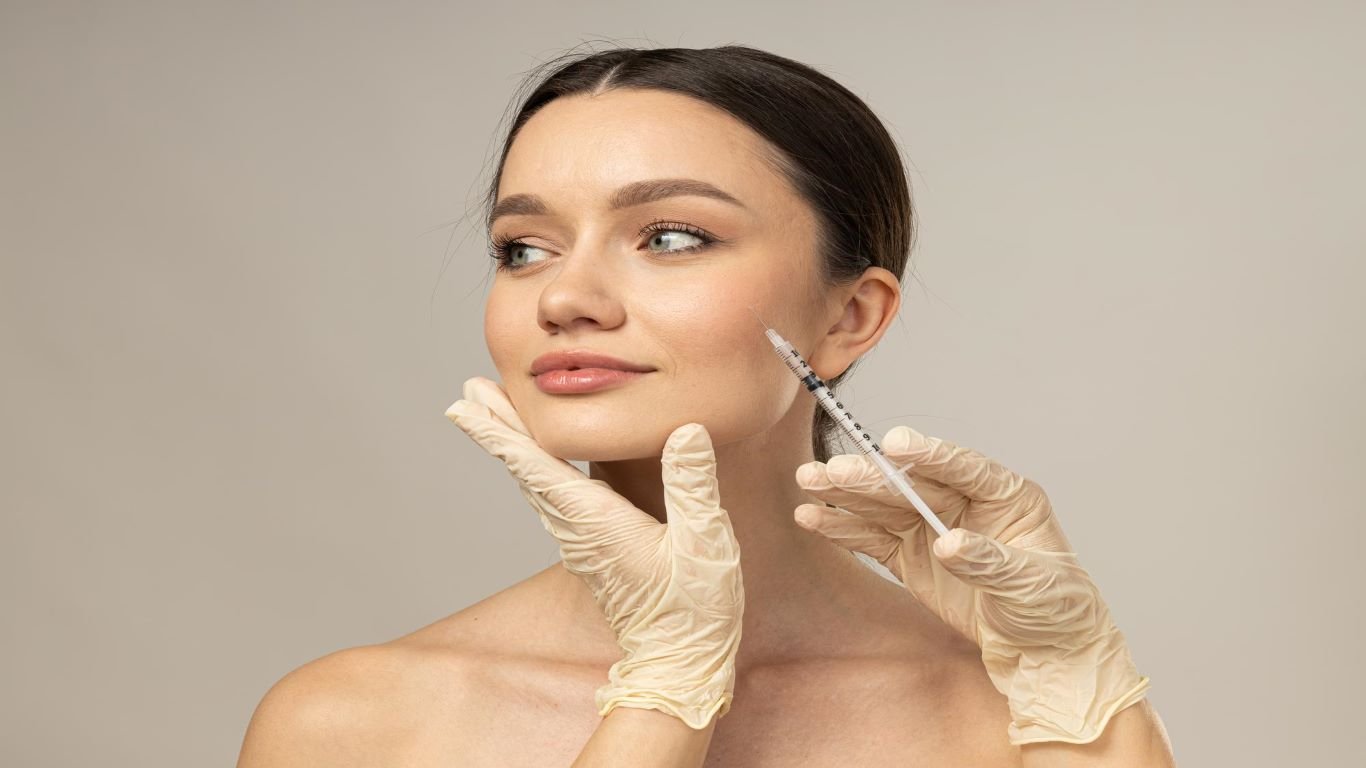Are you longing for youthful, radiant skin? Dermal Fillers might be the answer you’ve been searching for. In this comprehensive guide, we’ll dive deep into the world of Dermal Fillers, exploring what they are, how they work, and why they have become famous for those seeking rejuvenation.
What Are Dermal Fillers?
Dermal fillers help reduce facial wrinkles while restoring volume and fullness to the face. Our faces naturally lose subcutaneous fat as we age. Because the facial muscles are now operating closer to the skin’s surface, smile lines and crow’s feet become more visible.
The facial skin also extends somewhat, contributing to the loss of facial volume. Sun exposure, genes, and lifestyle are further factors that influence the facial skin.
Why Are Dermal Fillers Used?
Your body begins to lose collagen as you get older. Collagen is vital throughout your body, including skin, muscles, bones, and connective tissues. Skin laxity (looseness) and volume loss are caused by low collagen levels in your skin. Skin thins loses suppleness, and begins to droop.
You can use dermal fillers to:
- Add volume to sagging skin.
- Make your facial characteristics more symmetrical.
- Fill in the lips and cheekbones.
- Smooth out wrinkles and creases on your face.
Some drugs used to treat medical illnesses such as HIV and AIDS can induce facial thinning. After taking these medications, some people obtain dermal fillers to restore volume to their faces.
What Are The Types Of Dermal Fillers?
There are numerous forms of dermal fillers. In addition to “off-the-shelf” fillers created from synthetic (man-made) materials and compounds found naturally in your body, healthcare providers can employ fat. This operation is known as “autologous fat grafting,” in which fat is extracted from one portion of your body and injected into your face.
The following are some examples of off-the-shelf fillers:
- Hyaluronic acid (HA) is a naturally occurring acid in the skin. It adds volume to your skin while keeping it moisturized. Your body produces less hyaluronic acid as you age. The effects of HA injections ordinarily last six to twelve months. Restylane® is a typical kind of HA filler.
- Calcium hydroxylapatite (CaHA) is a filler made of a material found in your bones. The effects of these fillers usually endure for around a year. Doctors typically use CaHA fillers for deeper wrinkles. CaHA fillers include Radiesse®.
- Polylactic acid (PLLA) is a chemical that helps your body produce collagen. Medical professionals commonly use polylactic acid to smooth deep wrinkles on your face. The effects can endure for two years or longer. Sculptra® is an example of a PLLA filler.
- Polymethylmethacrylate (PMMA) fillers comprise collagen and very few balls that remain under your skin after your healthcare professional injects them. The balls offer your skin volume and firmness. Bellafill® is one type of PMMA filler.
Your doctor will review the many types of dermal fillers and help you choose the best one. Talk to them about setting realistic goals and the expected outcomes after injections.
What Happens Before A Dermal Filler Procedure?
You’ll meet with your doctor before getting dermal fillers. You might want to see a dermatologist, a healthcare specialist specializing in skin care. They’ll evaluate your face and inquire about your goals and places you’d like to improve.
They may mark your face with a pen or marker to illustrate where the injections will be. They might also photograph your face. Your healthcare physician will recommend a specific type of filler or fillers and discuss potential side effects and recovery time.
Your healthcare practitioner will also inquire about your medical history during this visit. It’s critical to inform them if you’re taking any medications, as some medications can raise the chance of problems after fillers. Inform your doctor if you have:
- Allergies.
- There is a history of bruising or bleeding following similar operations.
- Problems with the nervous system.
- Skin conditions.

What Happens During A Dermal Filler Procedure?
Dermal fillers can be obtained at your doctor’s clinic. Some prefer to acquire dermal fillers at a medical spa (medspa or medispa). This is a medical clinic that offers cosmetic operations in a spa-like setting. Your healthcare professional may use an anesthetic lotion or cream to clean your skin. The anesthetic numbs the area, making the procedure more comfortable.
Your healthcare professional will inject minor fillers under your skin with a fine needle. The needle will pinch or sting, but most people do not feel much discomfort during these injections. Your doctor may inject fillers in multiple locations. The entire process can take a few minutes or up to an hour.
What Happens After A Dermal Filler Procedure?
Following dermal filler injections, your healthcare provider will wash your skin. They may give you an ice pack to relieve discomfort and swelling.
After the injections, you may experience bruises, swelling, or soreness. These side effects are typically minimal and resolve within a few days.
Many patients notice immediate effects after receiving these shots. However, everyone’s outcomes vary. The time it takes to see the impact (and how long they last) is determined by various factors, including the sort of treatment you had.
What Are The Advantages Of Dermal Filler Procedures?
Many patients get immediate improvements from dermal fillers. The injections typically take less than an hour and can be administered in your healthcare provider’s office. Because it is a non-surgical treatment, recovery time is brief. Results can last months or even years, depending on the type of filler. Some fillers might last for more than two years. Dermal fillers are also less expensive than elective surgical procedures.
What Are The Risks Or Complications Of Dermal Fillers?
Serious issues are uncommon, and some side effects are transient. However, like with any cosmetic surgical operation, there are hazards. These are some examples:
- Asymmetrical look.
- There is bleeding, bruising, redness, soreness, and swelling.
- Scarring is caused by skin damage.
- Infection can lead to severe necrosis (death of the diseased skin).
- Lumps or lumps under your skin.
- Numbness.
- Acne-like pimples.
- Rush and itching.
People rarely experience eyesight difficulties as a result of dermal filler injections. If you have problems with your vision, weakness, discomfort, or pain on one side of your body, get emergency medical attention.
What Are The Most Common Dermal Fillers Side Effects?
Asymmetry, bruising, lumps and bumps. Most adverse effects are minor, transitory, and will disappear with time. Bruising is more prevalent when needles are used instead of cannulas. Bruising is more common at several injection sites, such as the lips or the area around the mouth. Medication, supplements (fish oil, vitamin E, St John’s Wort), and injector technique are all variables.
Asymmetry of filler is prevalent on the lips and nose (midline structures). A tiny amount of asymmetry is expected and acceptable for cheek fillers, temple fillers, jowl fillers, and fillers around the eyes. The vast majority of situations do not necessitate adjustment. If necessary, your injectable provider can discuss options for correcting asymmetry. In most circumstances, a small amount of filler is applied to the opposite side. In other cases, it may entail dissolving a minimal amount on the overcorrected side (a more difficult task).
What Is The Recovery Time After Getting Dermal Fillers?
Each person’s healing time is unique. Your healing time is affected by the following:
- How many parts of your body were treated by your healthcare provider?
- The kind of filler you received.
- Your general well-being.
Most people can resume their normal activities immediately after receiving dermal filler injections. However, your doctor may advise you to rest from strenuous exercise or physical activity for a day or two.

How Much Are Dermal Fillers Cost?
According to the American Society of Plastic Surgeons, dermal fillers are charged per syringe. The cost depends on the type of filler and its components. To attain the desired benefits, most individuals require more than one syringe.
Costs as an example:
- Radiesse and other calcium hydroxylapatite fillings cost $717.
- Restylane and the Juvéderm® range of hyaluronic acid fillers: $684
- Sculptra and other polylactic acid fillers cost $853.
- Bellafill® polymethyl-methacrylate microspheres: $1,058
- During your initial meeting, question your doctor about the cost of the entire procedure.
When Should I Consult With My Doctor Regarding Dermal Fillers?
If you have any of the following symptoms after receiving dermal fillers:
- There is no bleeding or pain.
- Infection symptoms include fever, redness, and swelling at the injection site.
- Difficulty breathing or shortness of breath (dyspnea) are symptoms of an allergic reaction or anaphylaxis.
Dermal fillers fill in wrinkles and add volume to drooping skin. Many prefer these injections because the results are quick and the recovery time is short. Side effects are possible with every elective cosmetic operation. Consult our healthcare professional at Alyssum Cosmetic about the dangers and benefits of dermal fillers and the best type for you. If you have bleeding, pain, swelling, or signs of an allergic response after receiving these injections, contact your healthcare professional.
FAQs
Are Dermal Fillers Painful?
Dermal Filler injections are generally well-tolerated. You may feel a slight pinch, but the discomfort is minimal.
How Long Do Dermal Filler Results Last?
The longevity of results varies, but they typically last from 6 months to over a year.
Can I Combine Dermal Fillers with Other Treatments?
Yes, many people combine Dermal Fillers with Botox for comprehensive facial rejuvenation.
Are There Any Side Effects?
Common side effects include redness, swelling, and bruising, which are typically temporary.
Is Dermal Filler Safe?
Yes, when administered by a qualified practitioner, Dermal Fillers are safe.
Who Is a Good Candidate for Dermal Fillers?
Dermal Fillers are suitable for anyone looking to enhance their facial features or reduce signs of aging.






